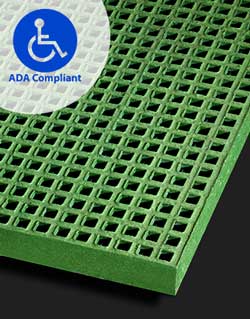What Does it Mean when FRP Grating is ADA-Compliant?
Gratings are indispensable in a variety of commercial and industrial settings, providing a stable floor base with ideal traction which helps to keep your workers and visitors safe daily. Their unique configuration of parallel/perpendicular flanges eliminates the problem of standing water and also contributes to sturdier catwalks and walkways with reduced weight. But the engineering benefits of grating systems can be outweighed by a loss of accessibility.
FRP grating is a viable alternative to aluminum and stainless steel structures which struggle to balance excellent construction qualities with the necessary accessibility for a truly inclusive workforce. But what makes FRP a better alternative to metal grating when it comes to design and accessibility? To answer that, you need to understand the basics of ADA compliance.
What is ADA Compliance? (And What Does it Mean for Your Site?)
The Americans with Disabilities Act (ADA) Standards for Accessible Design was established by the Department of Justice in 2010. It set out new guidelines for ensuring that people with disabilities can access and use facilities, primarily focussing on accessible entrances and the replacement of stairs with ramps or lifts. But the minutiae of the act cover all aspect of facility design, from the height consistency of handrails through to the uniformity of ant-slip stair treads. So, what does this mean in the context of FRP grating?
What is ADA Grating?
 ADA-compliant grating allows a maximum permissible opening between cross bars of ½” wide in a single direction, creating a more tightly spaced floor base. Additionally, any grating designed with elongated openings should be positioned so that the long dimension is perpendicular to the main direction of travel. For instance, on a catwalk, the primary profiles should run from handrail-to-rail. Lastly, the uppermost surface of the walkway should be composed of an slip-resistant material. All of this provides better support for pedestrians or workers who use mobility aids.
ADA-compliant grating allows a maximum permissible opening between cross bars of ½” wide in a single direction, creating a more tightly spaced floor base. Additionally, any grating designed with elongated openings should be positioned so that the long dimension is perpendicular to the main direction of travel. For instance, on a catwalk, the primary profiles should run from handrail-to-rail. Lastly, the uppermost surface of the walkway should be composed of an slip-resistant material. All of this provides better support for pedestrians or workers who use mobility aids.
Why Use FRP Grating for ADA Compliance?
FRP grating is naturally corrosion resistant and structurally strong. It is composed of fiber reinforced polymers which can be molded or pultruded into a wide range of profiles, then easily assembled into custom configurations. This makes it ideal for constructing ADA-compliant flooring in a wide range of commercial, industrial, and public settings.
At Strongwell, we have produced a range of FRP grating solutions using both precision molding and pultrusion. Our molded DURAGRATE® FRP grating is a premium-quality mesh panel featuring no elongated openings, and with an inherently good slip-resistance, it meets ADA requirements regardless of direction of travel. As an added benefit, our mesh FRP grating typically exceeds metal grids in terms of both engineering performance and cost of fabrication/installation.
Regulations are just one critical aspect to consider when selecting a grating product for your facility. Read our five tips for fiberglass FRP grating selection to learn more.